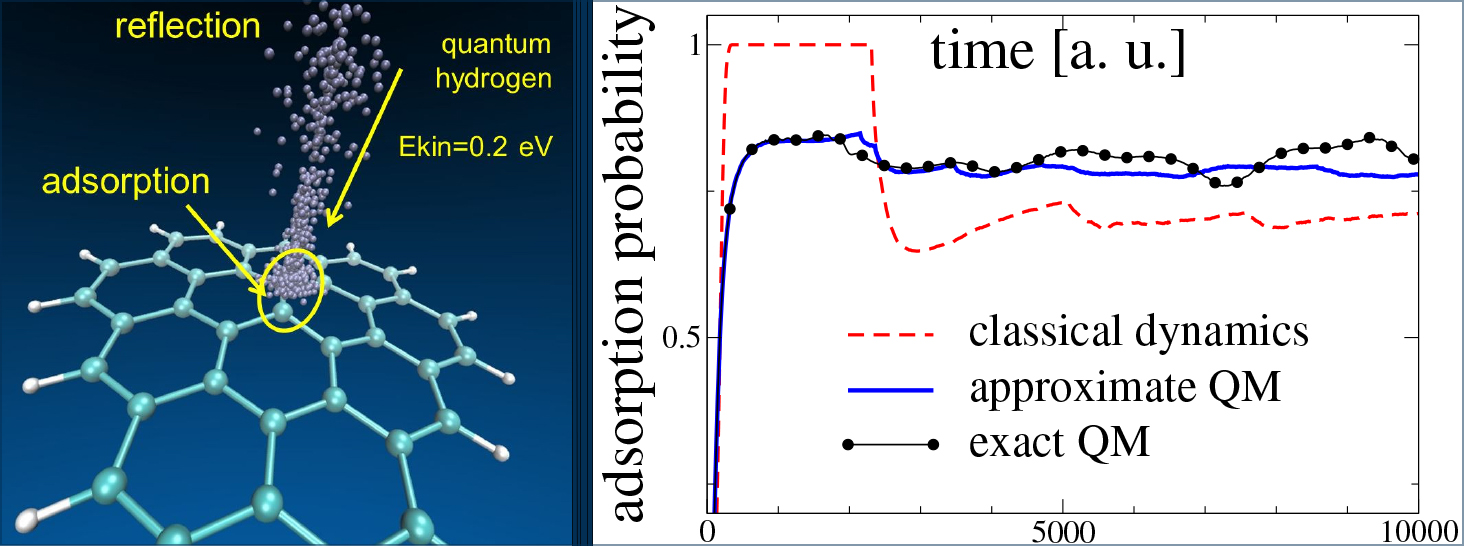KNOXVILLE, Tenn., Jan. 15, 2014

Researchers at the National Institute for Computational Sciences (NICS), the Center for Nanophase Materials Sciences at Oak Ridge National Laboratory (ORNL), and the University of South Carolina (USC) have developed a new computational capability to study the dynamics of prospective energy materials under diverse environmental situations. This new method employs quantum mechanics to understand how nuclear effects change the dynamics of nanoscale (microscopic-size) materials. The researchers used the NICS-managed Kraken supercomputer to perform massively parallel modeling and simulation studies in which a graphene (carbon) flake was bombarded by an ensemble of 1,000 hydrogen atoms to examine the likelihood of accumulation (adsorption) of the hydrogen on the porous graphene surface. They found that quantum nuclear effects are responsible for increased adsorption selectivity of deuterium over hydrogen on graphene. Understanding how materials with light nuclei—most especially hydrogen—behave on nanoporous surfaces is essential in the design of new materials for energy science applications.
Details of the study are contained in an article titled “Quantum Trajectory-Electronic Structure Approach for Exploring Nuclear Effects in the Dynamics of Nanomaterials” recently published in the Journal of Chemical Theory and Computation Along with Jacek Jakowski of NICS, the research team members and co-authors of the article were Sophya Garashchuk and Lei Wang of the Department of Chemistry and Biochemistry at USC, and Bobby Sumpter of the Center for Nanophase Materials Sciences and Computer Science and Mathematics Division at ORNL. Jakowski was principal investigator for the compute allocation on Kraken.
“The method we have developed is a general and robust tool that allows the study of processes involving hydrogen and its quantum nuclear effects for energy and materials applications, including hydrogen adsorption and storage, energy conversion at various conditions of temperature, pressure, and so forth; but also, for example, proton hydrogen transfer and tunneling in biological materials,” Jakowski said.
Jakowski explained that including quantum effects in the dynamics of many-atom systems is so difficult that almost all simulation studies neglect the effects with the hope that they are insignificant. “The heavier the nuclei, the more this assumption is valid,” he said. “But hydrogen and deuterium are the lightest nuclei. In our research we demonstrate that neglecting the quantum nature of nuclei leads to qualitatively different results. Hydrogen and deuterium are very light and so quantum effects are particularly pronounced.”
The article states that the method used in the project was “a hybrid of approximate quantum trajectory dynamics with electronic structure calculations performed on the fly.” Jakowski explained that examining electronic structure is by far the most expensive computational step in quantum nuclear dynamics studies and requires a massive machine like Kraken using many processor cores plus accelerators to compute quantum-force approximations within a practical time frame.

Left: A snapshot of a graphene (carbon) flake under bombardment by an ensemble of 1,000 hydrogen atoms. Right: Graph of the time-dependent absorption probability of hydrogen on the graphene flake. The results were obtained from classic dynamics, computational quantum-mechanical approximations, and from exact quantum evolution.
“This research showed that quantum effects are important in understanding the interactivity of hydrogen with graphene,” Jakowski said. “This work marries the study of electronic structure and quantum mechanics, and opens the door to new interesting scientific studies and applications.”
The adsorption of hydrogen or other light molecules on nanoporous materials has implications for energy science applications such as hydrogen storage and fuel cells, as well as molecular sieving; the sieving is often used in the petroleum industry for the purification of gas streams.
About NICS: The National Institute for Computational Sciences (NICS) operates the University of Tennessee supercomputing center, funded in part by the National Science Foundation. NICS is a major partner in NSF’s Extreme Science and Engineering Discovery Environment, known as XSEDE.